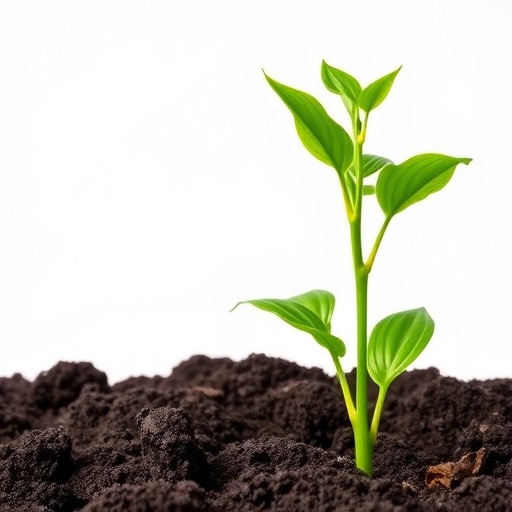In the quest for sustainable agricultural practices, scientists continue to explore innovative solutions to combat soil contamination, particularly from heavy metals like chromium. A recent study led by researchers Muthusamy, Rajendran, and Ezhilan presents groundbreaking findings on the use of biochar and thiourea-modified biochar in mitigating chromium’s detrimental effects on crops. The research specifically focuses on the implications of these amendments for the green gram, or Vigna radiata, within chromium-contaminated agricultural soil—a scenario that poses significant risks to plant health and, consequently, food security.
Chromium contamination often arises from industrial discharges, agricultural runoff, and improper waste disposal, leading to both soil degradation and increased bioavailability of this toxic element. The presence of chromium not only adversely affects soil microbial ecosystems but also poses severe physiological challenges to plants. It disrupts essential biochemical mechanisms, leading to oxidative stress, which can hinder crop growth and productivity. Given these alarming effects, it is crucial to investigate practical and efficient methods to restore soil health and enhance crop resilience.
The concept of utilizing biochar—a charcoal-like substance produced from pyrolyzing organic materials—has gained traction in recent years. Biochar is lauded for its ability to improve soil properties, enhance nutrient retention, and sequester carbon. In their study, the researchers sought to examine how the application of biochar, alongside its thiourea-modified variant, could reduce chromium bioavailability and alleviate its toxicity in Vigna radiata. Thiourea, known for its complexation properties, may further enhance biochar’s ability to bind heavy metals, thus limiting their uptake by plants.
Prior to conducting their experiments, the scientists established a baseline understanding of the oxidative stress mechanisms triggered by chromium exposure in Vigna radiata. It was vital to elucidate the physiological processes at play, particularly how this heavy metal induces reactive oxygen species (ROS) production within plant tissues. An excess of ROS can lead to cellular damage, affecting critical cellular components such as proteins, lipids, and nucleic acids. This damage not only hampers growth but also interrupts metabolic functions necessary for plant survival.
To evaluate the effectiveness of biochar and thiourea-modified biochar in mitigating chromium’s adverse effects, the researchers implemented a series of controlled pot experiments. They cultivated Vigna radiata in chromium-contaminated soil and implemented different treatment groups: one with standard biochar, another with thiourea-modified biochar, and a control group without any amendments. This experimental design allowed them to meticulously monitor plant responses, providing clarity on how each treatment influenced oxidative stress and overall plant health.
Results from the study revealed that both biochar treatments significantly reduced chromium bioavailability in the soil, demonstrating the potential of these amendments to immobilize heavy metals effectively. Notably, the thiourea-modified biochar exhibited superior performance compared to standard biochar, likely due to its enhanced chelation properties. This interaction curbed the absorption of chromium by Vigna radiata, mitigating toxicity levels and fostering improved growth parameters.
The physiological impact of these treatments was evident in the measured antioxidative responses of the plants. The researchers observed a marked increase in the activities of antioxidative enzymes such as superoxide dismutase (SOD) and catalase (CAT) in plants treated with biochar and thiourea-modified biochar. These enzymes play crucial roles in detoxifying ROS, thereby conferring a protective effect against oxidative stress. Consequently, plants receiving these amendments exhibited enhanced growth rates, increased chlorophyll content, and improved biomass accumulation relative to the control group.
Furthermore, the alteration of soil microbial communities due to biochar application cannot be overlooked. The study noted that amendments led to a more diverse microbial profile in treated soils, which is integral for enhancing soil health and fertility. Increased microbial activity contributes to better nutrient cycling and soil structure, further supporting plant growth. This symbiotic relationship underscores the significance of biochar not just as a soil additive but as a tool for promoting a holistic approach to soil management.
The implications of this research extend beyond the laboratory. As agricultural practices increasingly face the challenges posed by soil contamination, the application of biochar and its modified forms could serve as a viable strategy for sustainable farming. By reducing metal toxicity, improving crop resilience, and restoring soil health, these techniques could greatly benefit farmers working in contaminated regions. The potential for improved crop yields also presents an attractive proposition for food security in areas struggling with soil degradation.
In summary, the findings of Muthusamy and colleagues mark a critical step forward in our understanding of how soil amendments can combat heavy metal contamination. The interaction between biochar, thiourea, and Vigna radiata illustrates the complex relationships at play within the soil-plant continuum. As further research builds upon these results, we may unlock new pathways to not only revitalize contaminated soils but also to foster an agricultural landscape that is more resilient to the impacts of industrialization and climate change.
The adoption of biochar-based amendments has the potential to reshape modern agricultural practices. Through continued exploration and innovative applications, researchers can contribute to creating a safer, more sustainable environment for future generations. The collaboration between scientific inquiry and practical agricultural solutions will be pivotal in addressing the pressing challenges posed by soil contamination.
Ultimately, this study emphasizes the importance of interdisciplinary approaches in tackling environmental issues. The findings advocate for the integration of molecular biology, chemistry, and agricultural sciences to address the multifaceted challenges that arise in contaminated ecosystems. By promoting sustainable practices guided by empirical research, we can pave the way toward a greener, healthier planet.
Subject of Research: Mitigation of chromium bioavailability and toxicity in Vigna radiata through biochar amendments.
Article Title: Amendment of biochar and thiourea-modified biochar to mitigate chromium bioavailability and toxicity by modulating oxidative stress system in Vigna radiata in chromium-contaminated agriculture soil.
Article References:
Muthusamy, L., Rajendran, M., Ezhilan, V.K. et al. Amendment of biochar and thiourea-modified biochar to mitigate chromium bioavailability and toxicity by modulating oxidative stress system in Vigna radiata in chromium-contaminated agriculture soil.
Environ Sci Pollut Res (2025). https://doi.org/10.1007/s11356-025-36855-w
Image Credits: AI Generated
DOI:
Keywords: Chromium, Biochar, Oxidative Stress, Vigna radiata, Soil Contamination, Sustainable Agriculture.




